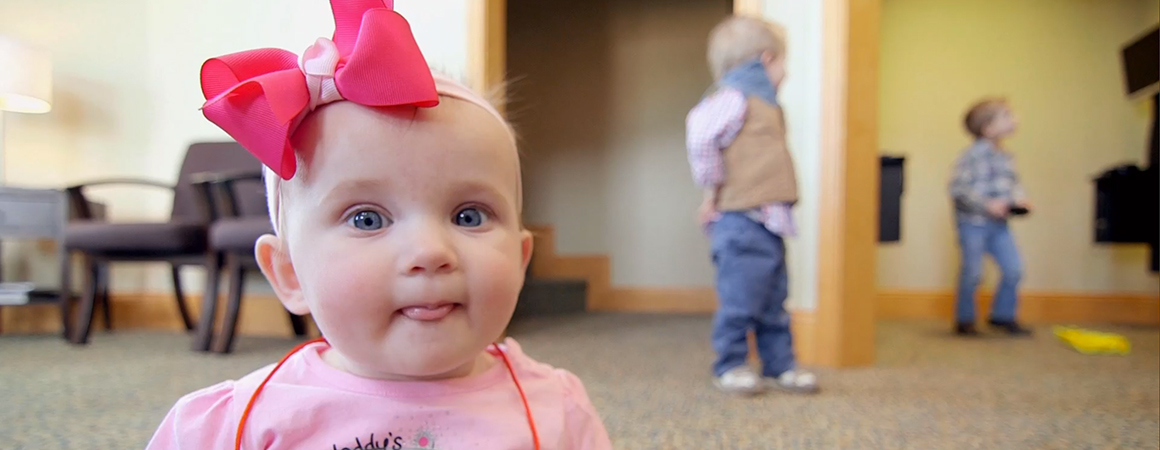Pediatric Dentist – Kid’s Dentist

Denzinger Family Dentistry cares for patients of all ages, from tiny infants to senior citizens. We love to get involved with your family’s dental care early, so our staff is dedicated to continuing education to understand the current treatments and techniques unique to children and pediatric dentistry. We can help with topics ranging from your child’s first dental visit, trauma to front teeth, using dental sealants, establishing good home oral hygiene habits, foods to avoid, thumb and pacifier habits, and more.
Early Dental Care
Tongue-Tied or Poor Latching During Breastfeeding
Between 4% and 10% of children are born with some degree of frenulum restriction, also known as tongue-tie or lip-tie. This means that their tongues and lips are attached to the mouth with excessive connective tissue webbing. This excess tissue impedes the movement of the tongue or lips to various degrees, and can make it difficult for infants to latch during breastfeeding. It can also impact speech and eating in children and adults. We have unique experience to safely and conveniently correct this condition utilizing orthodontics or the latest laser treatment technology for minimal discomfort and fast healing.
First Visit By First Birthday
While it might seem early, your child should have their first pediatric dentist visit when their first tooth comes in, usually between 6 and 12 months of age. This will help you establish a dental care team for your child and early examination and preventative care will protect your child’s smile.
Teething Advice
From six months to age three, your child may have tender gums when teeth erupt. Many children like a clean teething ring, cool spoon or cold wet washcloth. Simply rubbing your baby’s gums with a clean finger can also soothe them.
Potential Early Dental Issues
Dental problems can begin early. One concern is Early Childhood Caries (or baby bottle tooth decay). Once a child’s diet includes anything besides breast-milk, their erupted teeth are at risk for decay. The earlier your dental visit, the better the chance of preventing dental problems. Start your child now on a lifetime of good dental habits.
Finger and Thumb Sucking
Thumb sucking is perfectly normal for infants…many stop by age two. Prolonged thumb sucking can create crooked teeth or bite problems. If the habit continues beyond age three, a professional evaluation is recommended. We will be glad to suggest ways to address a prolonged thumb sucking habit.
Early Tooth Development
Throughout your child’s life, they will have two sets of teeth: primary (baby) teeth and secondary (permanent) teeth.
Baby Teeth
At birth the developing teeth are usually still embedded in the gums. For most infants, the front teeth begin to peek through the gums between four and eight months. Generally, children get four new teeth every month. The teeth begin to form when the infant is around six months old. By the time the baby reaches 12 to 15 months old, all of the primary teeth within the gums have formed crowns. Most children have all 20 baby teeth by 2 ½ to 3 years of age. Permanent teeth continue to develop within the jaw.
Baby teeth erupt in pairs on the right and left of the mouth, alternating between the lower and upper jaws, and proceeding from front to back. The 20 primary teeth usually erupt in the following order:
- 4 front teeth or central incisors, first in the lower jaw and then in the upper jaw
- 4 lateral incisors, on each side of the front teeth, uppers before lowers
- 4 first molars, uppers first
- 4 canines or cuspids, between the lateral incisors and the first molars, usually uppers before lowers
- 4 second molars behind the first molars, lowers first
Baby teeth may come in straight or at an angle and appear crooked, but they eventually straighten out.
Permanent teeth
Between 2 ½ and 6 years of age, the permanent teeth continue to develop within the jaw. The six-year-molars, the first permanent teeth, erupt behind each of the four second baby molars, usually between the ages of 5 and 6. By about age eight, enamel has formed on all of the permanent teeth except the wisdom teeth. A permanent tooth comes in completely about two months after the corresponding baby tooth is lost. Between the ages of about age 6 and 12 to 14, as the jaw grows, 28 permanent teeth erupt, replacing the primary teeth, incisor for incisor, canine for canine, premolar or bicuspid for molar. The 32 permanent teeth generally erupt in the following order:
- 4 six-year molars
- 4 central incisors or front teeth, first in the lower jaw and then in the upper jaw
- 4 lateral incisors, lowers usually first
- 4 canine teeth, lowers first
- 4 first premolars or bicuspids, between the canines and the six-year molars, uppers usually first
- 4 second premolars or bicuspids, between the first premolars and the six-year or first molars, uppers usually first
- 4 second molars, behind the first molars, lowers usually first
- 4 third molars or wisdom teeth at the back, usually between ages 17 and 21
Get Started Today!
Call us at 812-941-1400 or fill out the contact form at right.
